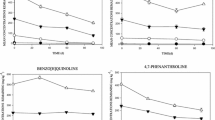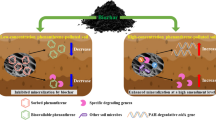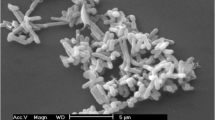Abstract
To assess the co-catabolism of phenanthrene and tricyclazole in different samples, the interaction during the degradation of phenanthrene and tricyclazole were investigated in medium, soil and soil/spent mushroom compost (SMC) mixture. Generally, tricyclazole showed a negative influence on the activity of phenanthrene dioxygenase and it inhibited the degradation of phenanthrene prominently, both in cultures of phenanthrene catabolic isolates (Sphingomonas paucimobilis ZX4 and the mixed flora M1) and soils, while a similar inhibition caused by phenanthrene was also found for the degradation of tricyclazole in soil/SMC. However, the inhibition effect on phenanthrene degradation was eliminated in soil/SMC mixture, due to the abundant microorganisms and enormous catabolic potential in SMC. Furthermore, it was proved that the negative influence between phenanthrene and tricyclazole was most likely derived from the molecular similarity and it tended to decrease with improved microbial diversity in environment.





Similar content being viewed by others
References
Ampe F, Miambi E (2000) Cluster analysis, richness and biodiversity indexes derived from denaturing gradient gel electrophoresis fingerprints of bacterial communities demonstrate that traditional maize fermentations are driven by the transformation process. Int J Food Microbiol 60:91–97
Andersson A, Jordan D, Schneider G, Lindqvist Y (1996) Crystal structure of the ternary complex of 1,3,8-trihydroxy-naphthalene reductase from Magnaporthe grisea with NADPH and active-site inhibitor. Structure 4:1161–1170
Bezalel L, Hadar Y, Cerniglia CE (1997) Enzymatic mechanisms involved in phenanthrene degradation by the white rot fungus pleurotus ostreatus. Appl Environ Microbiol 63:2495–2501
Boon N, Goris J, De Vos P, Verstraete W, Top EM (2000) Bioaugmentation of activated sludge by an indigenous 3-chloroaniline-degrading comamonas testosteroni strain, I2gfp. Appl Environ Microbiol 66:2906–2913
Chen SH, Aitken M (1999) Salicylate stimulates the degradation of high-molecular weight polycyclic aromatic hydrocarbons by pseudomonas saccharophila P15. Environ Sci Technol 33:435–439
Dong HS, Quan B, Chai EF, Mao XR (2002) The syntheses and crystal structure of novel 5-methyl-3-substituted-1,2,4-trizolo[3,4-b]benzothiazoles. J Mol Struct 608:41–47
Eschenbach A, Kastner M, Bierl R, Schaefer G, Mahro B (1994) Evaluation of a new, effective method to extract polycyclic aromatic hydrocarbons from soil samples. Chemosphere 28:683–692
Halling-Sorensen B, Nyholm N, Kusk KO, Jacobsson E (2000) Influence of nitrogen status on the bioconcentration of hydrophobic organic compounds to selenastrum capricornutum. Ecotoxicol Environ Saf 45:33–42
Lantz SE, Montgomery MT, Schultz WW, Pritchard PH, Spargo BJ, Mueller JG (1997) Constituents of an organic wood preservative that inhibit the fluoranthene degrading activity of sphingomonas paucimobilis strain EPA505. Environ Sci Technol 31:3573–3580
Lau KL, Tsang YY, Chiu SW (2003) Use of spent mushroom compost to bioremediate PAH-contaminated samples. Chemosphere 52:1539–1546
Lowry OH, Rosebrough NJ, Farr AL, Randall RJ (1951) Protein measurement with the folin phenol reagent. J Biol Chem 193:265–275
Meyer S, Steinhart H (2000) Effects of heterocyclic PAHs (N, S, O) on the biodegradation of typical tar oil PAHs in a soil/compost mixture. Chemosphere 40:359–367
Meyer S, Steinhart H (2001) Fate of PAHs and hetero-PAHs during biodegradation in a model soil/compost-system: formation of extractable metabolites. Water Air Soil Poll 132:215–231
Millette D, Barker JF, Comeau Y, Butler BJ, Frind EO, Clément B, Samson R (1995) Substrate interaction during aerobic biodegradation of creosote-related compounds: a factorial batch experiment. Environ Sci Technol 29:1944–1952
Nam K, Kim JY (2002) Role of loosely bound humic substances and humin in the bioavailability of phenanthrene aged in soil. Environ Pollut 118:427–433
Padovani L, Capri E, Padovani C, Puglisi E, Trevisan M (2006) Monitoring tricyclazole residues in rice paddy watersheds. Chemosphere 62:303–314
Roling-Wilfred FM, Milner MG, Jones DM, Lee K, Daniel F, Swannell-Richard JP, Head IM (2002) Robust hydrocarbon degradation and dynamics of bacterial communities during nutrient-enhanced oil spill bioremediation. Appl Environ Microbiol 67:5537–5548
Šašek V, Bhatt M, Cajthaml T, Malachová K, Lednická D (2003) Compost-mediated removal of polycyclic aromatic hydrocarbons from contaminated soil. Arch Environ Contam Toxicol 44:336–342
Schwartz E, Scow KM (2001) Repeated inoculation as a strategy for the remediation of low concentrations of phenanthrene in soil. Biodegradation 12:201–207
Semple KT, Watts NU, Fermor TR (1998) Influence of temperature on the mineralization of [UL-14C]benzene in spent mushroom compost. FEMS Microbiol Lett 164:317–321
Shailaja MS, Rodrigues A (2003) Nitrite-induced enhancement of toxicity of phenanthrene in fish and its implications for coastal waters. Estuar Coast Shelf Sci 56:1107–1110
Tian L, Ma P, Zhong JJ (2002) Kinetics and key enzyme activities of phenanthrene degradation by pseudomonas mendocina. Process Biochem 37:1431–1437
Tiehm A, Fritzsche C (1995) Utilization of solubilized and crystalline mixtures of polycyclic aromatic hydrocarbons by a mycobacterium sp. Appl Microbiol Biotechnol 42:964–968
Wheeler MH, Klich MA (1995) The effects of tricyclazole, pyroquilon, phthalide, and related fungicides on the production of conidial wall pigments by penicillium and aspergillus species. Pestic Biochem Phys 52:125–136
Wreen BA, Venosa AD (1996) Selective enumeration of aromatic and aliphatic hydrocarbon degrading bacteria by a most probable number procedure. Can J Microbiol 42:252–258
Xia Y, Min H, Zhou DP (2003) Characteristics and phylogenetic analysis of two phenanthrene-degrading bacteria. China Environ Sci 23:162–166
Xia Y, Min H, Rao G, Lv ZM, Liu J (2005) Isolation and characterization of phenanthrene-degrading Sphingomonas paucimobilis strain ZX4. Biodegradation 16:393–402
Acknowledgements
We are grateful to Dr. Haixia Yu and Dr. Meizheng Wang for their important contributions, and we appreciate Prof. Xin Chen (Institute of Agricultural Ecology, ZJU, China) for her help with HPLC system. We also sincerely thank the editors and reviewers for their precious help and suggestions. Financial support for part of this work was provided by National Science Foundation of China (30570053, 40501037) and Zhejiang Science and Technological department (021103722).
Author information
Authors and Affiliations
Corresponding author
Rights and permissions
About this article
Cite this article
Liu, J., Min, H. & Ye, L. The negative interaction between the degradation of phenanthrene and tricyclazole in medium, soil and soil/compost mixture. Biodegradation 19, 695–703 (2008). https://doi.org/10.1007/s10532-007-9174-y
Received:
Accepted:
Published:
Issue Date:
DOI: https://doi.org/10.1007/s10532-007-9174-y




